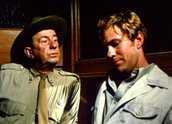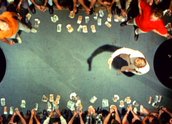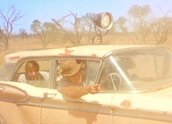


Wake in Fright (1971)
Synopsis
John Grant (Gary Bond) is the bored teacher at a one-room school in Tiboonda, a tiny railway junction on the far western plains of New South Wales. On his way to Sydney for Christmas, he stops overnight in Bundanyabba, a frontier mining town. The local policeman, Jock Crawford (Chips Rafferty), introduces him to after-hours drinking and a two-up game where he loses all his money. At the pub next morning, businessman Tim Hynes (Al Thomas) takes pity and invites him home for lunch. After a disastrous sexual encounter with the man’s voracious daughter Janette (Sylvia Kay), Grant gets drunk again with the enigmatic 'Doc’ Tydon (Donald Pleasence) and his two roughneck pals, Dick (Jack Thompson) and Joe (Peter Whittle).
He wakes up in Tydon’s dishevelled shack, to a breakfast of kangaroo hash and pills. Tydon is a disbarred doctor, describing himself as an alcoholic tramp who lives without money or pretence. He taunts Grant over his sexual failure with Janette Hynes. That night, Grant joins Tydon and his friends on a kangaroo shooting trip. He learns how to kill a wounded kangaroo with a knife. They trash an outback pub and he is sexually assaulted by the drunken Tydon. He tries to get away the next day by hitchhiking, but the truckie just brings him back to ‘The Yabba’. In a fury, he goes to Tydon’s shack to kill him, but succeeds only in wounding himself. After discharge from the hospital, Grant takes the train back to Tiboonda, for another year of teaching.
Curator’s notes
Wake in Fright is Australian cinema’s Paradise Lost. It is probably the most unflattering depiction of the country that has ever been filmed, but it remains a profoundly ambiguous work, suspended between disgust and a kind of admiration for the honest depravity of what it shows. In terms of the Australian film revival in the 1970s, it is one of two key films that galvanised the local industry – the other being Nicolas Roeg’s Walkabout (1971).
Both films opened in Australia in October 1971 after notable debuts at the Cannes Film Festival. Both were directed by foreigners and both showed the Australian outback as a kind of deadly apocalyptic landscape. Walkabout (1971) depicted whites as children lost in an Aboriginal version of the Garden of Eden; Wake in Fright was about how white civilisation had despoiled the Garden. The climactic kangaroo hunting scenes remain some of the most disturbing in any Australian film, mainly because most of the shots are real. (The cinematographers collected most of these before production began, on trips with kangaroo hunters).
John Milton’s epic poem Paradise Lost, published in 1667, tells the story of the fall of Man, and his temptation by Satan. Wake in Fright is virtually the same story. At the core of both is a question of free will, the freedom to choose. No-one forces John Grant into depravity; all they do is offer him the chance to choose it.
'The Yabba’ is the best place in Australia, says a taxi driver at the beginning of Grant’s odyssey. A kind of paradise, in other words, but Grant learns that he has arrived 'after the fall’. The place is populated almost exclusively by men; they drink in huge pubs that stay open regardless of the licensing laws; the only women we see are dull-eyed slatterns, numbed by boredom and the heat. After losing all his money, Grant meets a man, 'Doc’ Tydon, who is almost literally the devil. Over the the next 48 hours, Grant loses everything he holds dear – his sense of moral superiority, his physical strength, his dignity, and his inhibitions. The only man with whom he can hold an intelligent conversation – the doctor – turns out to be his undoing. And yet, as horrific as the experience is for Grant, he emerges stronger from the trauma. The film is constantly asking one question of him – are you a man? By the end of the film, he is closer to understanding that question, even if he may not know the answer.
The shock for Australian audiences – who did not particularly like the film at the time – was that the depravity was shown as normal, rather than aberrant. No-one except Grant, and perhaps the Doc, has any awareness of the fact that they live in a version of hell. Indeed, the Doc makes this clear in his first line in the film. As Grant sits down to a huge steak in the café attached to the two-up game, the Doc says, 'All the little devils are proud of hell’.
The film is based on a 1961 novel by Kenneth Cook, an Australian journalist, novelist and filmmaker who died in 1987. The rights were originally owned by the expatriate American director Joseph Losey, who wanted to film it with Dirk Bogarde. The film was eventually made as a co-production between an Australian company, NLT Productions, and an American subsidiary of Westinghouse, with a Canadian director and a Jamaican scriptwriter, Evan Jones. Jones had adapted the script for Two Gentlemen Sharing, a 1969 film directed by Ted Kotcheff, who was already an experienced director in film and television. Kotcheff had never worked in Australia. There was almost no Australian feature film industry at the time but there were a small number of locally trained crew with some international experience. Anthony Buckley, the editor, had worked with Michael Powell on Age of Consent, made in 1969.
Wake in Fright was selected for the 1971 Cannes Film Festival. It received glowing reviews in Australia, but limited success at the box office. After the late 1970s, it became almost impossible to see, because of the absence of any video or DVD. Tony Buckley began to search for the original negatives in the mid-1990s. With the support of the NFSA, the negatives were eventually found in a bin marked for destruction at the CBS vault at Iron Mountain, Pittsburgh, in the USA. These were returned to Australia, where Buckley collaborated with the NFSA and Atlab to restore the film to its original release version. (The only known difference between the two versions is that Gary Bond was shown naked in two shots in the Australian release, whereas he is shown wearing underpants in the international version).
The restored Wake in Fright was re-released in Australia during the winter of 2009, after a gala relaunch at the Cannes Film Festival in May, where it was the first Australian film ever selected to screen in the Cannes Classics program.
- Overview
- Curator’s notes
- Video 3 clips
- Principal credits
- Find a copy
- Comments 3
- Map
- Extras
- Reviews 1



